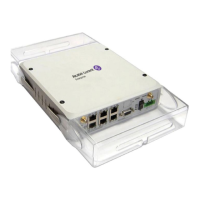Show Commands
Page 534 7750 SR OS Interface Configuration Guide
FEC Mode
Type of FEC (Forward Error Correction) in effect: g709, enhanced or
disabled. When g709 is selected, the standard FEC method is used.
When enhanced is selected, a proprietary FEC algorithm is used that
extends optical reach in long haul applications. When disabled the
bytes that are reserved for FEC in the OTU frame are transmitted as
zeros and the FEC decoder is bypassed, but OTU framing is still in
effect.
Data Rate
This indicates the data rate at which the port is operating. When OTU
is encapsulating 10-Gigabit Ethernet WAN, the data rate is 10.709 Gb/
s, the G.709 standard OTU2 data rate. When OTU is encapsulating 10-
Gigabit Ethernet LAN, the data rate is either 11.049 Gb/s or 11.096
Gb/s, depending on the otu2-lan-data-rate configuration parameter of
the port's OTU parameters. These data rates (11.049 Gb/s and 11.096
Gb/s) are considered OTU2e data rates that are non-standard or over-
clocked with respect to G.709, but have become widely used in optical
networking to transport un-altered 10-Gigabit Ethernet LAN payloads.
Cfg Alarms and
Alarm Status
This indicates the alarms that shall be reported when raised or cleared.
Alarms that are not in this list will not be reported when they are raised
or cleared but will appear in the Alarm Status.
SF/SD Method
This indicates the selected method for declaring the SF (Signal Fail) or
SD (Signal Degrade) alarm. When BIP8 is selected, the error rate of
SM-BIP8 errors in the OTU frames is used to declare SF or SD (This is
very similar to SONET SF/SD which uses a rate of B2 errors). When
FEC is selected, the rate of corrected bits is used to declare SF or SD.
This effectively indicates that the link would be degraded (SD) or
failed (SF) if FEC was disabled and gives the user an early warning
that the link is degrading or is about to fail.
SF Threshold
This is the configured error rate threshold at which the SF (Signal Fail)
alarm will be raised.
SD Threshold
This is the configured error rate threshold at which the SD (Signal
Degrade) alarm will be raised.
SM-TTI Tx (<mode>)
This is the configured SM-TTI (Section Monitor Trail Trace Identifier)
to be transmitted by this port in the OTU overhead bytes. The modes
are auto, string, or bytes. In the auto and string modes, a printable char-
acter string will be displayed. In bytes mode, up to 64 hex bytes will be
displayed
SM-TTI Rx
This is the SM-TTI (Section Monitor Trail Trace Identifier received by
this port. When the received TTI is a printable string of characters, it
will be displayed as a text string. When the received TTI contains one
or more non-printable characters, it will be displayed at a sequence of
64 hex bytes. When the received TTI is all zeros, the string “Not Spec-
ified” will be displayed.
Label Description (Continued)

